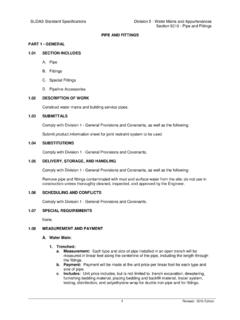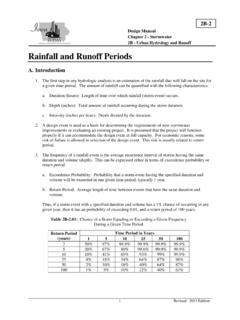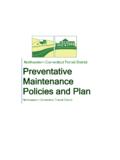Transcription of Section 8B-1 - Layout and Design - Statewide …
1 8B-1. Design Manual Chapter 8 - Parking Lots 8B - Layout and Design Layout and Design A. Parking Lot Access Properly designed parking lot access provides for safe and efficient movement of vehicles into and out of the parking lot. Refer to Chapter 5 - Roadway Design for additional information on access management and driveway Design , spacing, and location selection. The most efficient approach to designing parking lot access places a priority on moving inbound traffic from the public roadway into the facility. Entrances should be located on major streets, align with interior traffic lanes/aisles, and direct inbound traffic toward the destination.
2 Traffic control within the lot should provide inbound traffic the right-of-way. Favoring inbound traffic expedites the rapid movement of vehicles from the street into the facility and prevents vehicles from lining up on public roadways. Where a high volume parking lot is adjacent to a high volume or high speed roadway, a dedicated deceleration/turning lane at the entrance helps eliminate rear-end accidents. Exits should be located away from the destination point and discharge vehicles onto lower volume adjacent side streets if possible. Since exiting traffic tends to move more slowly, drivers can more comfortably navigate the turns required to reach the exit.
3 Vehicles queued to exit the parking lot will stack up inside the lot and will not affect traffic on the public street. Where separate entrances and exits cannot be provided, the driveway to the parking lot should be at least 24 feet wide to provide two 12 foot lanes. Traffic studies may be required for entrances to large retail centers, event facilities, or businesses with large numbers of employees entering or exiting the lot at the beginning or end of a work day or shift. B. Parking Lot Circulation Off-street parking lots should be designed to accommodate traffic volumes and pedestrian circulation based on the land use served.
4 The use of islands, medians, curbing, and landscaping is encouraged to separate parking spaces from traffic and pedestrian circulation areas. Parking spaces at entrance and exit points should be terminated (except at one and two family dwelling units) to prevent conflict between vehicles attempting to enter or exit the parking space, and vehicles attempting to enter or exit the parking lot. Access between adjacent commercial parking lots should be considered. This allows patrons to travel from one business to the adjacent business without entering the public street and then turning immediately into the next parking area.
5 These types of movements can cause operational problems on the public street. 1 Revised: 2013 Edition Chapter 8 - Parking Lots Section 8B-1 - Layout and Design C. Parking Lot Dimensions 1. Parking Spaces: In order to determine parking space sizes, the Design vehicle size must be defined. Since 1999, the size of the 85th percentile vehicle on the road has varied slightly, but has remained within an inch or two of 6 feet, 7 inches wide by 17 feet, 3 inches long. In addition to vehicle size, the designer must consider the intended function of the parking facility. For example, facilities with high turnover rates, such as convenience stores, should have greater clearances than those with low turnover rates.
6 In addition, where a significant portion of users may be elderly, such as at hospitals, larger dimensions may be appropriate. Parking spaces that provide sufficient clearance for doors to be opened and occupants to enter and exit will also provide adequate width for maneuvering if the adjacent aisle is wide enough. Door opening clearances should range from 23 inches in low turnover facilities to 27 inches in high turnover facilities. Table lists recommended parking stall widths on the basis of turnover. Table : Recommended Minimum Widths for Parking Stalls Facility Type Width Low turnover (employees, students, etc) 8'-6.
7 Moderate to high turnover (retail, medical facilities, etc.) 9'-0 . Source: Urban Land Institute, National Parking Association For stalls that are adjacent to walls, curbs, islands, or other obstructions, increase the stall width by at least 12 inches to allow for door opening and to reduce the risk of tripping. Unlike width, the length of a parking space is not affected by turnover rate or user type. The recommended length of a parking space is 18 feet. The length of the parking space may be modified up to 2 feet, if vehicle overhang is allowed. However, the designer should be aware that the aerodynamic Design of many current vehicles often does not provide sufficient vertical clearance for vehicles to pull forward over the curb.
8 2. Parking Module Design : The drive aisle is the space between two parking stalls directly across from one another. The term module refers to the width of the drive aisle combined with the length of the parking stalls on one or both sides of the drive aisle. Table lists recommended minimum dimensions for parking facilities. Figure provides further definition of the terms used in Table The only dimension that varies by stall width is the interlock dimension. An interlock occurs with angled parking when two stalls in adjacent modules align. The overlap at the front of the stalls is the interlock dimension. When a parking facility is designed to take advantage of interlock, the effective width of the module may be reduced by the interlock dimension.
9 For aisles with interlocking spaces on both sides, the effective width of the module may be reduced by two times the interlock distance. This approach can provide a more efficient parking lot facility and reduce the overall surface area required for the parking lot. Because snow can obscure pavement markings, vehicles will often pull too far into a parking space, which reduces the width of the aisle in the adjacent module. This has been taken into consideration in Table Therefore, when a curb, wall, or other physical restraint is provided for on at least 30% of the stalls, the aisle width (and therefore the overall module width).
10 May be reduced by 1 foot. 2 Revised: 2013 Edition Chapter 8 - Parking Lots Section 8B-1 - Layout and Design Table : Minimum Parking Dimensions Parking Angle ( ). Parking Lot Dimension Two-way Aisle One-way Aisle 90 60 45 60 45 . Stall Projection SP 18'-0 15'-7 12'-9 15'-7 12'-9 . Aisle Width A 24'-0 25'-10 29'-8 20'-4 21'-6 . Base Module M1 60'-0 57'-0 55'-2 51'-6 47'-0 . Single Loaded Module M2 42'-0 39'-0 37'-7 32'-6 29'-5 . Wall to Interlock M3 60'-0 55'-10 52'-2 49'-4 44'-0 . Interlock to Interlock M4 60'-0 53'-8 49'-2 47'-2 41'-0 . Overhang o 2'-6 2'-2 1'-9 2'-2 1'-9 . Width Projection WP 8'-6 9'-10 12'-0 9'-10 12'-0.





